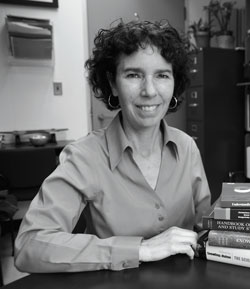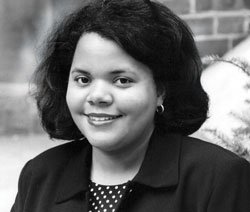Putting Standards to the Test
During the past 30 years, U.S. education has become increasingly standards-driven. Are we getting anywhere?
SINCE 1892, WHEN THE National Education Association appointed the "Committee of Ten" to rethink high school education, the United States has wrestled with whether and how to set standards for what American students should learn. And since 1904, when TC's E.L. Thorndike published An Introduction to the Theory of Mental and Social Measurements, educators have sought ways to assess whether students are hitting the mark.
Since the late 1980s, a new standards movement has sought to bring greater coherence to state education systems and again has triggered parallel developments in assessment. Forty-five states have recently adopted the Common Core State Standards -- a new set of learning and performance standards in math and English for grades 1-12 that was developed by the Council of Chief State School Officers and the National Governors Association Center for Best Practices. Assessments geared to the Common Core are due to be released in 2014.
What has the state standards movement accomplished, and where is it headed?
What was the genesis of the state standards movement?
JEFFREY HENIG: The idea of standards emerged out of a realistic and appropriate assessment that American education was so fragmented and diverse and localized that a fair amount of mediocre or even indifferent teaching was occurring unobserved in areas with low-income and minority students. Standards were meant to be a kick in the butt, particularly to districts, schools, principals and teachers who were content with "moving kids through."
SUSAN FUHRMAN: After the publication of "A Nation at Risk" in 1983, states came under pressure to improve student performance. ["A Nation at Risk: The Imperative for Educational Reform," was a report by the National Commission on Excellence in Education.] CPRE [the Consortium for Policy Research in Education] was funded by the federal government to analyze their efforts, and as Jeff says, our research findings showed that the state education reforms lacked coherence. Parts of the reforms were warring against other parts of the reforms -- for example, you had legislation that required students to take higher levels of math and science, but tests would focus on very basic, low-level skills. So people ended up adding courses such as "informal geometry," which was geometry without the proofs.
Other countries that scored well on international tests had more coordinated systems where teachers were prepared in the curriculum they were going to teach, and tests reflected that curriculum as well. A few states, like California, were beginning to think about more coherence. So, at a CPRE retreat in 1988, we talked about anchoring a more coherent system with a set of ambitious, publicly determined standards for what kids should know and be able to do. One of our members, Mike Smith, wrote about developing the ideas. Later he served in the Clinton Administration as a key education adviser and really pushed for that idea.
Overall, have standards been beneficial?
TOM CORCORAN: There's been some progress, though less than the politicians want or the reformers dreamed of, and the standards movement has been part of it. Test scores have gone up modestly in the last decade and in some states dramatically. We've seen movement of kids in the bottom quartile. And contrary to what our Secretary of Education says, there's been progress on international measures. Our scores have gone up on TIMSS [Trends in International Mathematics and Science Studies], and we're also one of only five countries that have made progress on PISA [Programme for International Student Assessment] in each of the last three administrations. But these gains have come at a cost. The curriculum has been narrowed in many schools and districts, and time for subjects like art, music and even science has been reduced or eliminated in districts under heavy accountability pressure.
HENIG: The attention paid to public education on the policy agenda has been increased thanks to the standards movement. In particular, the awareness of various forms of achievement gaps has been piqued and sustained, and a lot more people -- including some very smart and highly motivated people -- are thinking and working hard with serious aspirations to improve American education.
OK -- so let's talk about No Child Left Behind [NCLB]. This was a bipartisan bill passed in 2001 with great fanfare. Test scores have gone up. Yet, it's widely regarded as a failure. Why?
FUHRMAN: Under NCLB, states test everybody, every year, to demonstrate progress toward universal proficiency in math and English. That's skewed the whole system. The early visions of standards-based reform were that states would develop standards and use them to develop curriculum. Instead, states developed standards and nobody developed curriculum. They commissioned tests, and the test specs became the de facto curriculum, and they were much narrower than a curriculum should be. The early vision also included local capacity-building -- professional development for teachers pegged to the standards and support for students to reach the standards. But instead, whenever money was tight, professional development and subject-matter experts got cut.
RUTH VINZ: NCLB shows us what happens when we attempt to turn our dreams for education into statements of what we hope our children will learn and become. Standards are supposed to represent dreams, aspirations and beliefs, but when you move them off the page, the language often fails us. The implementation fails us. Our attempts distort and minimize the vision and the promise of education -'" to foster intelligence, inventiveness, humanness. We get lost in the forest of accountability and the rhetoric of prescription.
ENEST MORRELL: On the positive side, NCLB, like the standards movement in general, came from an equity agenda. Instead of saying, well, some kids can learn and some can't, NCLB said that consigning some kids to tracking and remedial courses was not OK -- that what's good for some kids is good for all kids.
But NCLB also showed us that standards are not neutral, that they can be used to supersede the power and autonomy of teachers. Administrators use standards like scripture. Teachers become technicians, not professionals and scholars who can adapt. Kids end up doing the same thing at the same time in the same way, and that's not how kids learn.
So now we have the Common Core State Standards. Will they be different? Will they promote more real learning?
LUCY CALKINS: At the broadest level, the Common Core represents progress. Under NCLB, each state made its own little measuring stick, and when someone said, "You've got to get better results," many states just made that measuring stick stupider. So the idea of common standards and assessments is huge.
Another positive, for me, is that the Common Core is calling for a new pedagogy. It challenges us to create deeper learning. But that will depend on whether teachers and principals are invited to experiment with instruction instead of simply being told how to get to the goal. Will they have a sense of agency about reimagining their classrooms, about collaborating and teaching each other, and about turning learning over to the kids more? Will they own the goals? People need to have their signature on something to feel invested.
CORCORAN: With the Common Core, you have to talk about the math and literacy standards separately. The math standards rest on incomplete but still helpful research on how students learn mathematics. The learning progressions that have resulted from this research form the intellectual underpinnings for the math standards. The expectations are higher but there are also fewer topics at each grade level -- so we're moving away from curricula that are a mile wide and an inch deep. So, I think you'll see better math curricula develop that give teachers better guidance and more time to teach core concepts.
ERICA WALKER: There will be some challenges for math teachers, because some key concepts appear in earlier grades than previous state standards required, and in much more depth. That's exciting, but it will require support for teachers to adjust to these new expectations. In addition, textbooks will have to make more than cosmetic changes to address these curricular shifts of depth and timing. There's also an emphasis on using technology, not just in instruction, but also in assessment. Before, you might have used standard paper-and-pencil tests, but now, technology might be embedded in the assessment itself. For example, students might have to complete open-ended problems, which require them to design or explore something using technology, as part of the assessment.
That sounds more creative.
WALKER: As Ruth says, implementation will be the key. If things end up being just as test-driven as before, the standards could lead to less creativity, with math being reduced to a set of procedures. Take geometry. If a teacher has time, she can have students explore patterns and theorems in a way that builds conceptual understanding. For kids, it's cool to discover through exploration, for example, that pi is really an expression of a relationship -- the ratio of circumference to diameter -- that holds for any circle, instead of just being told that there's this relationship and to just follow this equation. But if testing is still paramount, teachers may end up teaching topics in isolation. They may just prepare kids to solve problems like the one on the state test, without providing the bigger picture.
In literacy, the Common Core says that now high-school students are supposed to read 70 percent nonfiction. Does that make sense?
MORRELL: It seems to me like voodoo science. Who came up with that number? Teachers ask me where it comes from, and I can't point to any research.
DOLORES PERIN: I have heard that some educators are concerned that the Common Core, on the literacy side, is a one-size-fits-all approach that takes away creativity and the love of literature. I can see that point, but we have a huge problem in this country. The main core of learning still comes from academic printed texts, but a lot of children aren't learning to read or write well enough to learn from those texts. The standards movement, as I understand it, is trying to ameliorate that situation. Unfortunately, the movement, if implemented strictly, won't be best for students who already read and write very well. But the problem is, we don't have an approach that accommodates both the lower-skilled and higher-skilled learner.
VINZ: I do worry about the place of creativity and imagination and invention in the 21st century. We live our lives by "what if" propositions, so why take that away from any students-'"struggling or not? I am puzzled at the misguided distinctions between nonfiction, literature and literary texts in the implementation of Common Core. Who makes such decisions on behalf of a nation? This 70 percent rule reflects an outlook in which creativity and imagination have become the ugly stepsisters of the ultimate goal: to educate students as critical thinkers who are college- and career-ready. Years ago, I worked with a teacher at a middle school near Morningside Park. We taught a memoir unit to get kids to look at themselves, their families, their neighborhoods. After about three days, a sixth-grader named Raymond said, "Ma'am I don't want to write about my life; I have to live it." He actually said that. And I said, "What do you want to write?" He said, "Science fiction." And, he started creating worlds, his own "what if" propositions, and in doing that he started
to study black holes, constellations, robots, and he was off and running -'" writing, imagining, researching, inventing his "what if" worlds. Maybe he'll be our next Ray Bradbury or work at NASA. Standards should challenge our "what if" propositions.
Another emphasis of the Common Core literacy standards is on "close reading." What does that mean, and is it good or bad?
CALKINS: The term "close reading" has a history in reading instruction, but the term has been reincarnated recently by the Revised Publisher's Criterion to the Common Core, a document written by David Coleman and Sue Pimental that has not been ratified by 25 states, but is often misinterpreted as being the Common Core. This document places a priority on close reading, suggesting that students need to learn to ask and answer text-based questions, to reread passages multiple times and to "stay within the four corners of the text." Many people assume the emphasis on close reading is an effort to swing the pendulum away from personal response.
MORRELL: Who's going to be against the idea of enabling students to do close reading? But there are intimations in the standards that context and culture don't matter -- that it's all about what's on the page -- and that's questioned by feminists and communities of color who believe that having a sense of an author's values is important. If you leave out context, kids may not feel the license to be critical of a text, because they lose the ability to draw on personal experience. Narrative ways of learning and knowing are regarded as soft and inconsequential.
Dolores, you've done a lot of work around content-area literacy and career readiness. Do the standards address that?
PERIN: I think we need to figure out what struggling readers will eventually need to develop their careers. The Common Core focuses primarily on college readiness, which is not the same thing as career readiness. It focuses on disciplinary literacy -- for example, history and science --and that's great, but it has to do with preparation for college. Career readiness means one thing for someone getting an associate degree and another for an aspiring philosophy professor. A radiology technician or a subway operator needs to be able to read text, solve problems independently, report issues in what could become legal documents -- but do they really need all those disciplinary standards that are in the Common Core? And are other things missing? It's an incredibly difficult discussion, and I'm not at all advocating a tracked system. But until we look at the career readiness issue in the cold light of day, we're not getting students who are employable. Those who are struggling readers are floundering, and we can't just pretend that everyone wants to or can easily go and do a BA.
MORRELL: But at what point should we be encouraging kids to identify a career track? Hopefully, we could agree that 10 years of education, through the ninth grade, is a base where we want all kids to have access to a skill set, such as how to read and make rhetorical arguments, that's going to help them choose a career. But even then, are kids really choosing of their own volition? When there are no girls going into engineering and no kids of color, can we really say that the playing field is level and that everyone is being given an equal shot?
One last question. The standards have been adopted. The assessments are in the works and will soon be deployed. What will the experience be like for teachers, parents and kids?
FUHRMAN: I don't see enough investment in professional development, in bringing the standards to life. States are trying to ratchet up their current tests, and we're likely to see high failure rates occurring for several years and a very bumpy transition.
CALKINS: New York State's students recently took an altogether new test, which gives all of us a window into what the next generation of testing will be like. The test was extremely challenging for students and asked for a lot of analytic reading. Students were asked questions such as, "What is the purpose of the image in paragraph 6?" and "Which of these paragraphs best supports the theme?"
The word is out that the percentage of children passing the test will plummet. This comes at the same time when all the teachers in New York State face evaluations based largely on their students' scores. Earlier this year, New Yorkers faced a perfect storm, Sandy. I predict that education, too, will face a perfect storm.
HENIG: I understand why many educators are resistant and fearful, but there's a risk of throwing out the baby with the bathwater. It's important to remember that along the long historical arc, there's another vision of standards that educators have articulated and responded to. So the question is: Can educators be part of a counter-movement that reclaims the healthier part of standards?
Published Wednesday, Jun. 26, 2013







